Related Research Articles
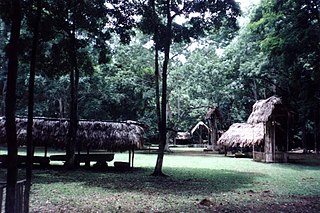
Dos Pilas is a Pre-Columbian site of the Maya civilization located in what is now the department of Petén, Guatemala. It dates to the Late Classic Period, and was founded by an offshoot of the dynasty of the great city of Tikal in AD 629 in order to control trade routes in the Petexbatún region, particularly the Pasión River. In AD 648 Dos Pilas broke away from Tikal and became a vassal state of Calakmul, although the first two kings of Dos Pilas continued to use the same emblem glyph that Tikal did. It was a predator state from the beginning, conquering Itzan, Arroyo de Piedra and Tamarindito. Dos Pilas and a nearby city, Aguateca, eventually became the twin capitals of a single ruling dynasty. The kingdom as a whole has been named as the Petexbatun Kingdom, after Lake Petexbatún, a body of water draining into the Pasión River.

Sir John Eric Sidney Thompson was a leading English Mesoamerican archaeologist, ethnohistorian, and epigrapher. While working in the United States, he dominated Maya studies and particularly the study of the Maya script until well into the 1960s.

Tat'yana Avenirovna Proskuriakova was a Russian-American Mayanist scholar and archaeologist who contributed significantly to the deciphering of Maya hieroglyphs, the writing system of the pre-Columbian Maya civilization of Mesoamerica.

Michael Douglas Coe was an American archaeologist, anthropologist, epigrapher, and author. He is known for his research on pre-Columbian Mesoamerica, particularly the Maya, and was among the foremost Mayanists of the late twentieth century. He specialised in comparative studies of ancient tropical forest civilizations, such as those of Central America and Southeast Asia. He held the chair of Charles J. MacCurdy Professor of Anthropology, Emeritus, Yale University, and was curator emeritus of the Anthropology collection in the Peabody Museum of Natural History, where he had been curator from 1968 to 1994.
David Humiston Kelley was an American archaeologist and epigrapher. He was associated with the University of Nebraska-Lincoln, and later with the University of Calgary. He is most noted for his work on the phonetic analysis and major contributions toward the decipherment of the writing system used by the Maya civilization of pre-Columbian Mesoamerica, the Maya script.
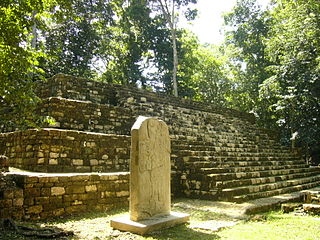
Aguateca is a Maya site located in northern Guatemala's Petexbatun Basin, in the department of Petén. The first settlements at Aguateca date to the Late Preclassic period. The center was occupied from about 200 B.C. until about 800 A.D., when the city was attacked and ransacked. Because the city was rapidly abandoned by its population, Pompeii-style assemblages were left scattered on the floors of elite residences. Horizontal excavation of these residences has revealed ancient elite activity and household level craft production areas. Aguateca sits on top of a 90 metres (300 ft) tall limestone bluff, creating a highly defensible position. This steep escarpment overlooks Petexbatun Lagoon in the Southwestern Guatemalan lowlands and is accessible by boat. There is an extensive system of defensive walls that surrounds the city, reaching over 3 miles (4.8 km) in length. Its center consisted on the Palace Group, which was probably a royal residential compound, and the Main Plaza. These monumental complexes were connected by a causeway, along which was a densely occupied elite residential area. During the reign of Tan Te' K'inich the city was invaded and burned. The city was completely abandoned around 830 AD. A 6-metre (20 ft) tall temple at the site was left unfinished, the centre of the city was destroyed by fire, valuables were left scattered in elite residences, and ceramics were left in their original domestic positions, all of which demonstrate the sudden abandonment of the city. The ruins of Aguateca are considered to be among the best preserved in Guatemala.

Tortuguero is an archaeological site in southernmost Tabasco, Mexico which supported a Maya city during the Classic period. The site is noteworthy for its use of the B'aakal emblem glyph also found as the primary title at Palenque. The site has been heavily damaged by looting and modern development; in the 1960s, a cement factory was built directly on top of the site.

Zapote Bobal is the modern name for a pre-Columbian Maya archaeological site located south of the San Pedro Martir river in the Petén department of Guatemala. The name Zapote Bobal was coined by archaeologist Ian Graham, who discovered the site in the 1970s. It refers to the large number of Zapote Bobo trees, which grow near abundant sources of water in the Petén Basin. The site languished in archaeological obscurity until 2003, when epigrapher David Stuart connected the archaeological site of Zapote Bobal with a name repeatedly mentioned in the inscriptions of sites like Piedras Negras and Yaxchilan. That name was the toponym Hix Witz, or "Jaguar Hill" Scholars had recognized this name for over 20 years, and its connection to a real place prompted the creation of an archaeological project at Zapote Bobal in 2003, the Proyecto Peten Noroccidente (PNO). It is currently directed by James Fitzsimmons and Laura Gamez.
Stephen Douglas Houston is an American anthropologist, archaeologist, epigrapher, and Mayanist scholar, who is particularly renowned for his research into the pre-Columbian Maya civilization of Mesoamerica. He is the author of a number of papers and books concerning topics such as the Maya script, the history, kingships and dynastic politics of the pre-Columbian Maya, and archaeological reports on several Maya archaeological sites, particularly Dos Pilas and El Zotz. In 2021, National Geographic noted that he participated in the correct cultural association assigned to a half-size replica discovered at the Tikal site of the six-story pyramid of the mighty Teotihuacan culture, which replicated its Citadel that includes the original Feathered Serpent Pyramid.
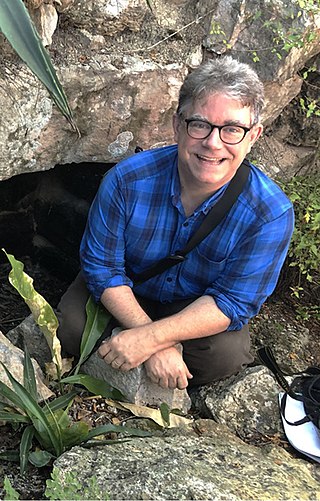
David S. Stuart is an archaeologist and epigrapher specializing in the study of ancient Mesoamerica, the area now called Mexico and Central America. His work has studied many aspects of the ancient Maya civilization. He is widely recognized for his breakthroughs in deciphering Maya hieroglyphs and interpreting Maya art and iconography, starting at an early age. He is the youngest person ever to receive a MacArthur Fellowship, at age 18. He currently teaches at the University of Texas at Austin and his current research focuses on the understanding of Maya culture, religion and history through their visual culture and writing system.
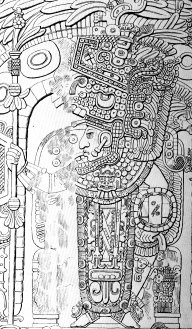
Yikʼin Chan Kʼawiil also known as Ruler B, Yaxkin Caan Chac and Sun Sky Rain,, was an ajaw of the Maya city of Tikal. He took the throne on December 8, 734.

The Maya civilization was a Mesoamerican civilization that existed from antiquity to the early modern period. It is known by its ancient temples and glyphs (script). The Maya script is the most sophisticated and highly developed writing system in the pre-Columbian Americas. The civilization is also noted for its art, architecture, mathematics, calendar, and astronomical system.
Pierre Robert Colas was a German anthropologist, archaeologist and epigrapher. As a Mayanist scholar who investigated the pre-Columbian Maya civilization of ancient Mesoamerica, Colas was well known for his contributions to the study of the Maya writing system, and his archaeological work on cave sites used by the Maya. His analysis of onomastics—personal naming practices and titles of rank—in Classic-era Maya inscriptions was the first major publication of its kind. Colas also conducted ethnographic studies and surveys among contemporary Maya communities living in Belize. In Europe, he had close involvement with the organisation of academic conferences and workshops on the Maya, as a workshop tutor, presenter of original papers, and editor of several conference proceedings and reports.

During the 7th and 8th centuries in Mesoamerica, there was an evident shift in the roles women played in ancient Maya society as compared with the previous two centuries. It was during this time that there was a great deal of political complexity seen both in Maya royal houses as well as in the Maya area. Warfare was a significant factor in political competition and marriage was one of the ways that alliances were made between the different polities. This was accompanied by a shift in women's roles from wife and mother to playing integral parts in courtly life, such as participating in rituals involving the supernatural world and at times ruling individual polities.

Peter Mathews is an Australian archaeologist, epigrapher, and Mayanist.
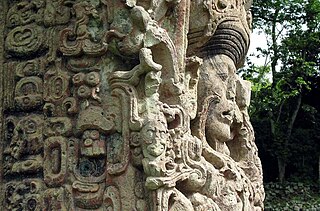
Maya stelae are monuments that were fashioned by the Maya civilization of ancient Mesoamerica. They consist of tall, sculpted stone shafts and are often associated with low circular stones referred to as altars, although their actual function is uncertain. Many stelae were sculpted in low relief, although plain monuments are found throughout the Maya region. The sculpting of these monuments spread throughout the Maya area during the Classic Period, and these pairings of sculpted stelae and circular altars are considered a hallmark of Classic Maya civilization. The earliest dated stela to have been found in situ in the Maya lowlands was recovered from the great city of Tikal in Guatemala. During the Classic Period almost every Maya kingdom in the southern lowlands raised stelae in its ceremonial centre.

Nikolai Grube is a German epigrapher. He was born in Bonn in 1962. Grube entered the University of Hamburg in 1982 and graduated in 1985. His doctoral thesis was published at the same university in 1990. After he received his doctorate, Grube moved to the University of Bonn. Nikolai Grube has been heavily involved in the decipherment of the Maya hieroglyphic script.

Maya cities were the centres of population of the pre-Columbian Maya civilization of Mesoamerica. They served the specialised roles of administration, commerce, manufacturing and religion that characterised ancient cities worldwide. Maya cities tended to be more dispersed than cities in other societies, even within Mesoamerica, as a result of adaptation to a lowland tropical environment that allowed food production amidst areas dedicated to other activities. They lacked the grid plans of the highland cities of central Mexico, such as Teotihuacán and Tenochtitlan. Maya kings ruled their kingdoms from palaces that were situated within the centre of their cities. Cities tended to be located in places that controlled trade routes or that could supply essential products. This allowed the elites that controlled trade to increase their wealth and status. Such cities were able to construct temples for public ceremonies, thus attracting further inhabitants to the city. Those cities that had favourable conditions for food production, combined with access to trade routes, were likely to develop into the capital cities of early Maya states.

Dzibanche is an archaeological site of the ancient Maya civilization located in southern Quintana Roo, in the Yucatan Peninsula of southeastern Mexico. Dzibanche was a major Maya city and investigations in the first decade of the 21st century indicate that it was the early capital of the Kan dynasty, which later ruled from the great city of Calakmul. Dzibanche features the earliest known use of the Kaan dynasty emblem glyph.

The history of Maya civilization is divided into three principal periods: the Preclassic, Classic and Postclassic periods; these were preceded by the Archaic Period, which saw the first settled villages and early developments in agriculture. Modern scholars regard these periods as arbitrary divisions of chronology of the Maya civilization, rather than indicative of cultural evolution or decadence. Definitions of the start and end dates of period spans can vary by as much as a century, depending on the author. The Preclassic lasted from approximately 3000 BC to approximately 250 AD; this was followed by the Classic, from 250 AD to roughly 950 AD, then by the Postclassic, from 950 AD to the middle of the 16th century. Each period is further subdivided:
References
- Appenzeller, Tim (4 November 1994). "Clashing Maya Superpowers Emerge From a New Analysis" (PDF online facsimile). Science . Washington, DC: American Association for the Advancement of Science. 266 (5186): 733–734. Bibcode:1994Sci...266..733A. doi:10.1126/science.266.5186.733. ISSN 0036-8075. OCLC 1644869. PMID 17730387.[ permanent dead link ]
- Demarest, Arthur A. (2006). The Petexbatun Regional Archaeological Project: A Multidisciplinary Study of the Maya Collapse. Vanderbilt Institute of Mesoamerican Archaeology series, vol. 1. Nashville, TN: Vanderbilt University Press. ISBN 978-0-8265-1520-9. OCLC 63178772.
- Fahsen, Federico (2002). "Rescuing the Origins of Dos Pilas Dynasty: A Salvage of Hieroglyphic Stairway #2, Structure L5-49". The Foundation Granting Department: Reports Submitted to FAMSI. Foundation for the Advancement of Mesoamerican Studies, Inc. (FAMSI) . Retrieved 5 November 2008.
- Inomata, Takeshi; Stephen D. Houston (eds.) (2001). Royal Courts of the Ancient Maya, vol. 1: Theories, Themes, and Comparisons. Boulder, CO: Westview Press. ISBN 0-8133-3640-6. OCLC 44914323.
{{cite book}}:|author2=has generic name (help) - Martin, Simon (Fall 2005). "Of Snakes and Bats: Shifting Identities at Calakmul" (PDF online reproduction by PARI Online Publications; repaginated from the print version). The PARI Journal . San Francisco, CA: Pre-Columbian Art Research Institute. 6 (2): 5–13. ISSN 1531-5398. OCLC 44780248.
- Martin, Simon; Nikolai Grube (November–December 1995). "Maya Superstates: How A Few Powerful Kingdoms Vied for Control of the Maya Lowlands during the Classic Period (A.D. 300–900)". Archaeology . Vol. 48, no. 6. New York: Archaeological Institute of America. pp. 41–46. ISSN 0003-8113. OCLC 91776603.
- Martin, Simon; Nikolai Grube (2000). Chronicle of the Maya Kings and Queens: Deciphering the Dynasties of the Ancient Maya. London and New York: Thames & Hudson. ISBN 0-500-05103-8. OCLC 47358325.
- Miller, Mary; Simon Martin (2004). Courtly Art of the Ancient Maya. London: Thames & Hudson. ISBN 0-500-05129-1. OCLC 54799516.
- Salisbury, David; Mimi Koumenalis; Barbara Moffett (19 September 2002). "Newly revealed hieroglyphs tell story of superpower conflict in the Maya world" (PDF). Exploration: The Online Research Journal of Vanderbilt University. Nashville, TN: Vanderbilt University Office of Science and Research Communications. OCLC 50324967. Archived from the original (PDF online publication) on 2 November 2014. Retrieved 3 March 2008.
- Schuster, Angela M.H. (September–October 1997). "The Search for Site Q" (online edition). Archaeology . Vol. 50, no. 5. New York: Archaeological Institute of America. pp. 42–45. ISSN 0003-8113. OCLC 200568756.
- West, Judy (November 2004). "Cracking the code of an ancient culture". Penn Current. Philadelphia: University of Pennsylvania: 3. Archived from the original on 7 June 2010. Retrieved 4 November 2008.